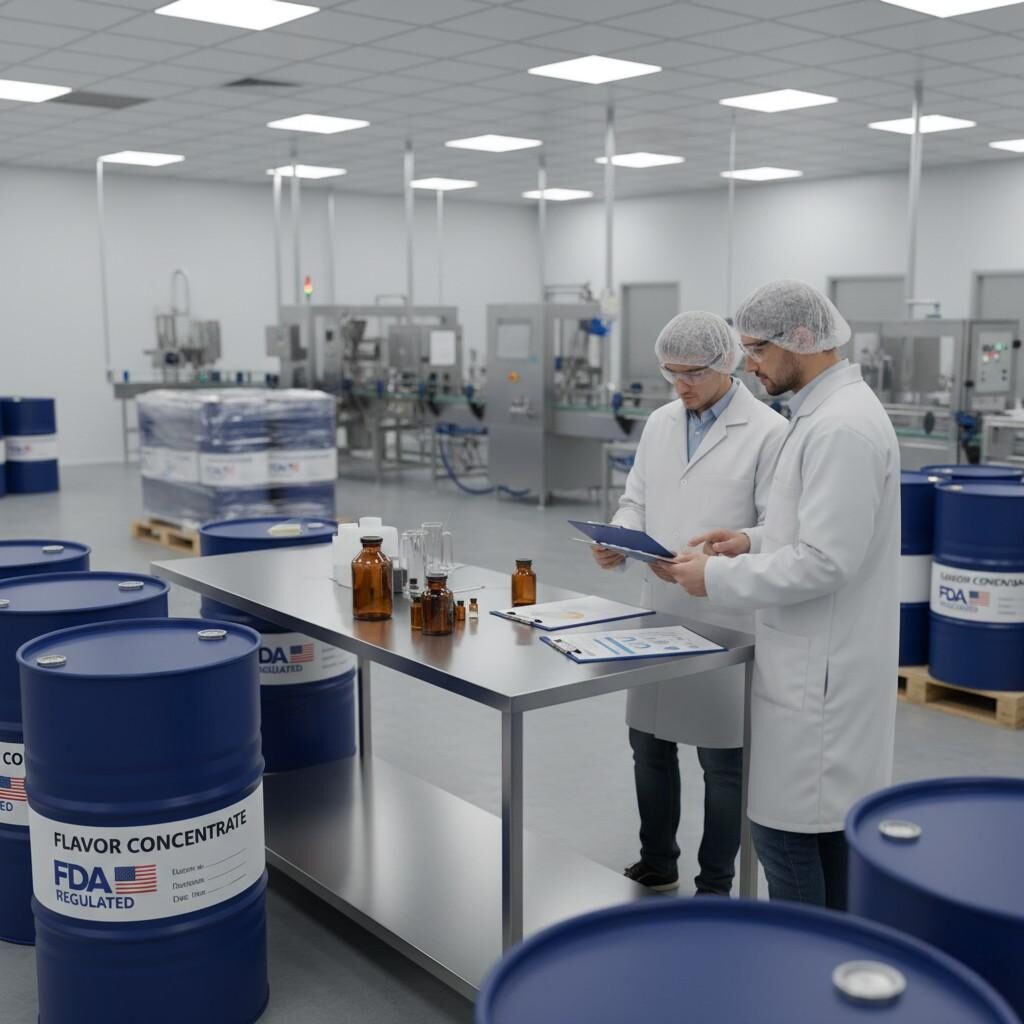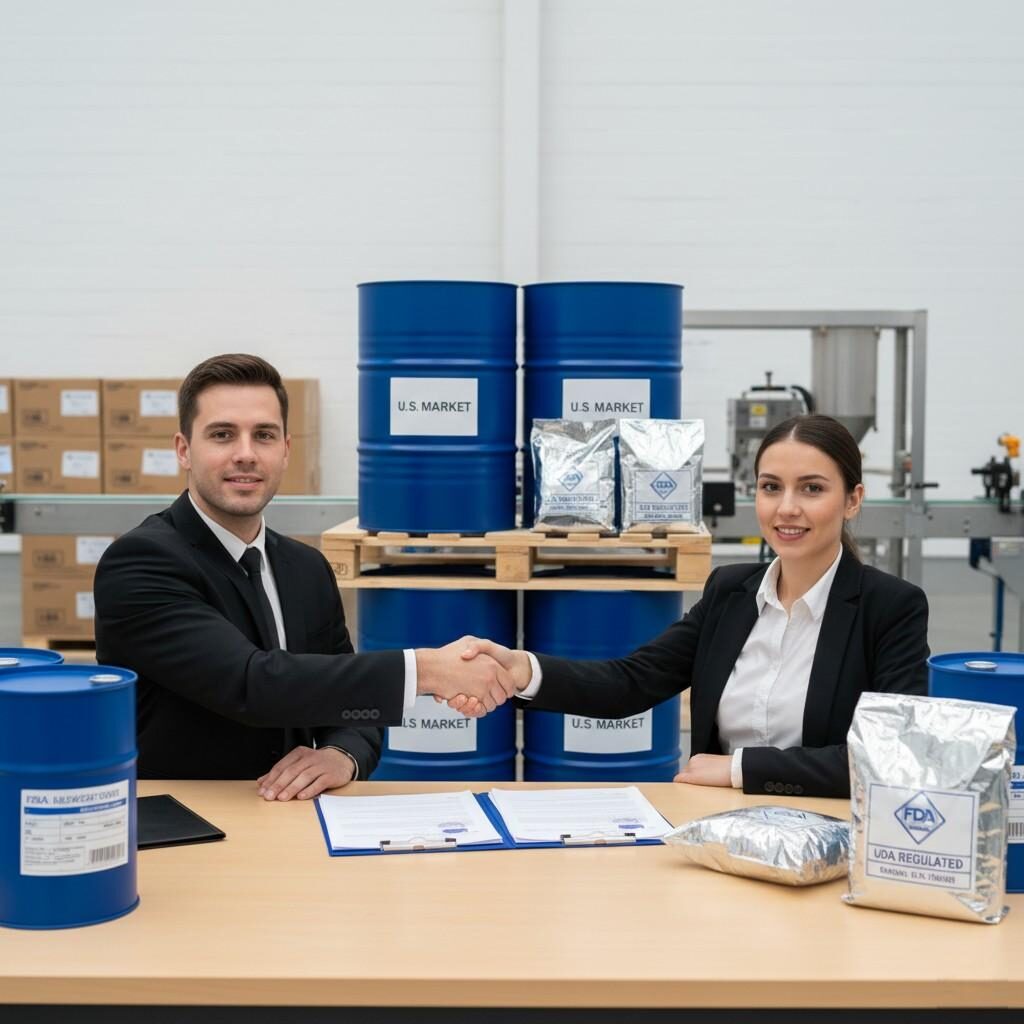Author: R&D Team, CUIGUAI Flavoring
Published by: Guangdong Unique Flavor Co., Ltd.
Last Updated: Nov 12, 2025

FDA Compliance Lab
In today’s competitive food & beverage (F&B) industry, flavour ingredients are a strategic component. For manufacturers of food-grade flavourings and for food & beverage producers who use them, understanding and navigating the regulatory requirements of the Food and Drug Administration (FDA) in the United States is not optional—it is essential. A mis-step in flavour compliance may lead to reformulation, product recall, regulatory warning letters, or damage to brand reputation.
This blog post, titled “US FDA Flavor Compliance: What Food Manufacturers Need to Know,” is crafted for professional flavour-ingredient manufacturers and food producers alike. We will provide technically-rich, well-structured guidance on how to achieve compliance with US flavouring regulations—including flavour definition, safety (GRAS & food additive petitions), labelling rules (21 CFR 101.22), documentation, supplier obligations, change-control, and best practices for integration into your QC/QA and supply-chain systems.
By the end of this article you will have a clear roadmap to align your flavour-ingredient formulations, production processes and documentation protocols with FDA requirements—helping you deliver compliant flavour modules, support your customers, and minimise regulatory risk.
The cornerstone regulation governing flavouring ingredients in the U.S. is the Federal Food, Drug, and Cosmetic Act (FD&C Act) which grants the FDA authority over “food” and “food additives.” Under this law, any substance added to food must either: (a) be generally recognized as safe (GRAS) for its intended use, or (b) be approved by FDA as a food-additive via petition.
In the context of food labelling, flavourings fall under the flavour-labelling regulation. Specifically, under 21 CFR 101.22 a flavour is defined as:
“any substance, the function of which is to impart flavor, which is used or intended for use in imparting flavor to a food, including any such substance that functions in this manner as a result of an interaction with other substances.”
Thus, even if a substance plays a secondary role but results in flavour impact, it is a flavouring ingredient and must comply with relevant rules.
A key compliance concept for flavour-manufacturers is whether a flavouring substance is GRAS or requires a food-additive petition. The FDA explains:
“In general … the safety of food additives and ingredients that are generally recognized as safe (GRAS) must be supported by science that demonstrates its use meets the FDA’s safety standard.”
If a flavouring substance is not GRAS, then the manufacturer must submit a petition with relevant chemical/technological/toxicological data.
For flavour-ingredient manufacturers, establishing GRAS status (or documenting equivalence to an existing GRAS flavour) is foundational for supply-chain compliance.
Under 21 CFR 101.22, the labelling of foods containing flavourings must follow specific rules. Key points include:
Although the food manufacturer bears ultimate responsibility, flavour-ingredient suppliers must support compliance by maintaining documentation (GRAS evidence, flavouring composition, usage levels), supporting downstream labelling, and enabling traceability of flavour lots, carriers, solvents, and processing. The FDA notes that “food manufacturers are responsible for marketing safe foods … including ensuring the safety and regulatory status of the ingredients they use in foods before they are available to consumers.”
As a flavour-ingredient manufacturer you must maintain an up-to-date inventory of all flavouring substances you use (including natural-flavour compounds, artificial flavouring compounds, carriers, extraction solvents, processing aids). For each substance you must know:
Failure to do so may result in your flavour module being used by downstream food manufacturers in a non-compliant manner.
Even if a flavouring substance is GRAS, you should maintain supporting data (e.g., analytical characterization, impurities, stability, usage levels). If you are using a flavouring that falls outside GRAS you must manage a food additive petition or confirm equivalence. Reference guidance from the FDA outlines required chemical and technological data for petitions.
Your flavour-QC system should monitor for impurities, residual solvents, stability of flavour compounds, and ensure that usage levels remain within the safe exposure limits assumed in GRAS determinations.
Flavour-modules often incorporate carriers (oils, emulsifiers, solvents), natural extracts, or “natural flavouring substances.” It is critical to ensure that carriers and processing aids themselves comply and that any “natural flavour” claim is substantiated. A study notes:
“Agency require food manufacturers to list the specific sources of the natural flavors.”
If you label a flavour as “natural,” its source and processing must comply with the definition of natural flavour in FDA’s regulatory framework and must support downstream labelling rules (21 CFR 101.22).

Flavor Compliance Testing
As a supplier of flavour-ingredients you must implement systems supporting product safety and regulatory compliance:
When your flavour-ingredient is used by a food manufacturer, you should provide a specification sheet including: flavour composition, usage level guidelines, carrier information, storage/handling instructions, expiry/shelf-life, and regulatory status (GRAS or petition). This helps your customer correctly label their finished food product and ensure flavour-compliance under FDA rules (labelling, ingredient listing, flavour designation).
Regulatory compliance is not static. Changes to raw-material suppliers, extraction methods, carriers, shelf-life, flavour composition or intended use require a review of regulatory status and downstream impact. You must maintain a change-control process that:
Under 21 CFR 101.22, a food product that uses a flavouring must declare the flavouring in the ingredient statement. For example, “Natural strawberry flavor” or “Artificial strawberry flavor,” depending on the source.
Furthermore, when a flavouring is the characterizing flavour (i.e., the flavour consumers associate with the food name), certain labelling nuances apply. For example:
If your product is “berry flavoured,” and that flavour comes from flavouring substances—not real berries—the label needs to reflect that (e.g., “natural berry flavored”).
Food producers must take care when making “natural flavour” claims. According to food labelling guidance and industry commentary:
“The name of the flavor must be included. It may have the word ‘natural’ in front of it, but it must have the word ‘flavored’ after it.”
Your flavour-supplier must support you by confirming that the flavouring substance qualifies as “natural flavour” under FDA guidance and meets the requirements of your finished product label.
While flavourings themselves may not always require detailed sub-ingredient listing, food manufacturers must still comply with allergen labeling (under the Food Allergen Labeling and Consumer Protection Act – FALCPA) and other applicable regulations (e.g., national nutrition labelling, packaging claims). Your flavour specification must clearly state whether the carrier or flavour module contains any allergen or allergenic-processing risk.
Food manufacturers rely on flavour-suppliers for the technical documentation and label-ready language (e.g., “natural orange flavour”) as well as ingredient declarations. You as the flavour-supplier should provide data or specification sheets supporting the consumer-labeling decisions of your customers, thereby enhancing trust and reducing downstream risk.
Many flavour-modules consist of complex blends of aroma compounds. While trade-secret formulation is understandable, from a regulatory perspective:
If a flavour-supplier changes raw-material sourcing, extraction method or carrier without updating the regulatory status, the flavour-module may become non-compliant (or the downstream finished food may mis-label). To manage this:
If you export flavour-modules to the U.S. from another country, you must ensure that your formulation meets U.S. requirements. Also account for:
Under FDA regulations, you must support your flavour-modules with documents such as usage-level calculations, toxicity/safety data, manufacturing specifications, shelf-life/stability data, and labelling support to your customers. Failure to maintain appropriate records may compromise compliance during audits.
While the regulatory focus is safety and labelling, food-manufacturers also face consumer scrutiny about “natural flavour,” “clean-label,” “non-GMO,” “all-natural.” As noted in media coverage:
“The safety of most ‘natural’ and ‘artificial’ flavors in U.S. food products is not regulated by the government but by the Flavor and Extract Manufacturers Association (FEMA)… critics argue that its self-policing system lacks transparency.”
As a flavour-supplier you must therefore enable your customers to respond to consumer questions about origin, safety and compliance.

Flavor Regulatory Review Meeting

US Market Flavor Partnership
If your organisation is seeking to align flavour-ingredient production with U.S. FDA regulatory requirements, we invite you to engage with our technical & regulatory team for a free consultation and sample pack of our flavour modules—complete with full specification sheets, GRAS/food-additive status documentation, usage guidance and labelling support. Let’s partner to deliver flavour solutions that are not only high-performance for your customers—but also fully compliant and auditable for U.S. market use.
Thank you for reading. Please share this post with your procurement, R&D, regulatory, QA/QC and production-teams—together we can raise the standard of flavour compliance and build stronger supply-chains.
📧 Email: [info@cuiguai.com]
🌐 Website: [www.cuiguai.cn]
📱 WhatsApp: [+86 189 2926 7983]
☎ Phone: [+86 0769 8838 0789]
Copyright © 2025 Guangdong Unique Flavor Co., Ltd. All Rights Reserved.